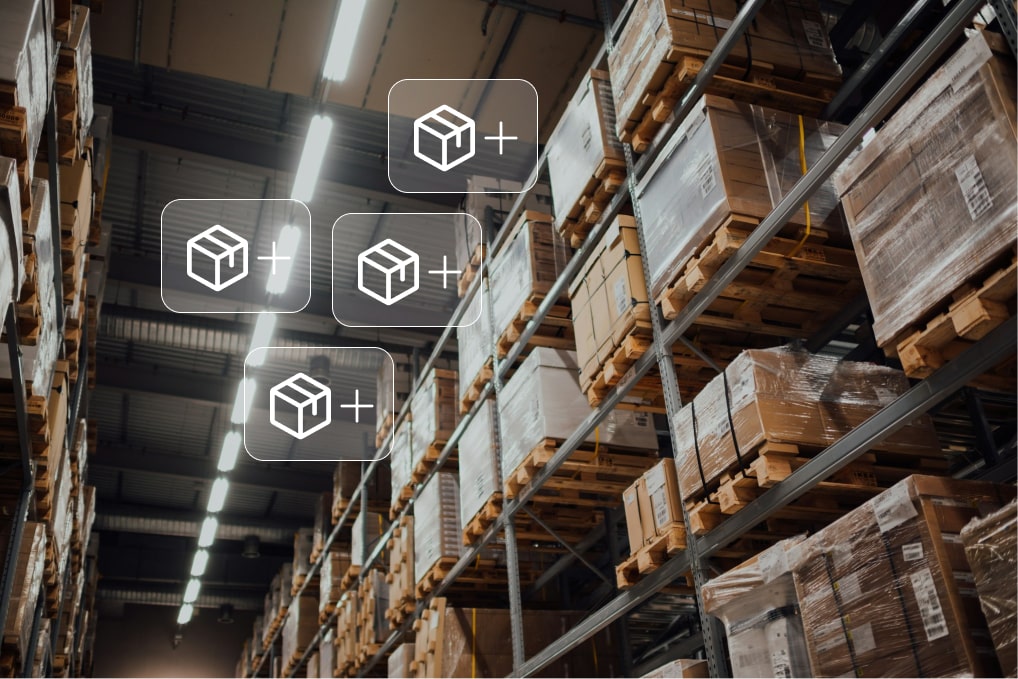
3 ways distributors can expand their offerings without investing in inventory
Have you acquired a new company? Expand your market share without tying up capital in inventory. How? The answer is not simple, but it exists. In this article, we will look at three proven models that will allow you to dramatically increase your market share without a proportional increase in capital requirements.

Why is this topic crucial for today's distributors?
Market share vs. capital efficiency
The fundamental dilemma of every wholesaler: How to get a bigger piece of the pie without having to bake a bigger pie?
The traditional model is simple but capital-intensive:
- Larger assortment = larger inventory purchases
- Larger inventory = tied-up capital + storage costs
- Risk of unsold, expired, or obsolete inventory
The hybrid model allows you to:
- Offer 10 times more assortment
- Tie up capital only in fast-moving items
- Respond to demand without prediction and speculation
- Serve niches that were previously unprofitable
Competitive advantage of the digital age
When your customer needs a specific product, they have two options:
- Order it from you (even if it takes 3-5 days)
- Look for it at a competitor
If they can't find it in your catalog, the likelihood that they will come back is low. A broader catalog = higher customer retention = higher customer lifetime value.
Model 1: Dropshipping with supplier shipping directly to the customer
How does it work?
This is the purest dropshipping model, where the supplier ships directly to the end customer on your behalf. You act as a business interface, but the goods never physically pass through your hands.
Technical process:
- Loading the product range:
- Your system connects to the supplier's API
- Products, prices, stock, and images are automatically synchronized
- Products are published on your e-shop with your margin
- Order:
- A customer orders 20 ergonomic chairs from your e-shop
- Your Cloudempiere system creates an order
- The system automatically forwards the order to the supplier (API or email)
- Shipping:
- The supplier ships the goods directly to the customer
- The delivery note includes your logo and company name (white label)
- The customer receives a package that looks like it came from you
- The supplier notifies you of the shipment
- Accounting process:
- The system "formally/accounting" accepts the goods into stock (even though you have not physically received it)
- It automatically generates a delivery note for the customer
- It automatically generates an invoice for the customer
- The supplier invoices you for your purchase
- You post the invoice and pay the supplier
Invoicing flow:
- You → Customer: Invoice for the retail price (e.g., $3,000)
- Supplier → You: Invoice for the purchase price (e.g., $2,200)
- Your margin: $800 without any inventory costs
Key advantage:
The goods never physically pass through your hands – they go directly from the supplier to the customer. You provide the business interface, marketing, customer service, and brand.
Advantages of the model
✅ Zero storage costs
✅ Zero capital tied up
✅ Dramatic expansion of your product range (thousands of products)
✅ Your brand remains visible (white label)
✅ No handling costs
✅ Automation via API
✅ Risk-free testing of new products
Disadvantages
❌ Dependence on the speed and reliability of the supplier
❌ Less control over packaging quality
❌ Longer delivery times (3-7 days)
❌ More complicated complaint resolution (the goods did not pass through your hands)
❌ You have no physical control over the goods
When to use it?
- You want to dramatically expand your product range (1,000-10,000 SKUs)
- You are testing demand for new product lines
- Low-turnover products (long tail)
- You don't have storage capacity
- You want to offer a "complete catalog" in your segment
- The supplier has reliable logistics and supports white-label
Model 2: External warehouses with your own shipping
How does it work?
This model combines the advantages of a wide range of products with full control over shipping. You don't have the products in stock, but you are the one who ships to the customer after a quick purchase from the supplier.
Technical process:
- Assortment in the e-shop:
- You offer an assortment in your e-shop that belongs to your portfolio
- You do not have it physically in stock
- But you can order it immediately from the supplier
- Integration via API displays availability as "At partner – delivery within 2 days"
- Order and purchase:
- The customer orders the product on your e-shop
- The system automatically creates a purchase order for the supplier
- The supplier delivers the goods to you (to your warehouse) the next day
- Regular purchase-sale process
- Shipping:
- You ship to the customer from your warehouse
- Full control over packaging, quality, delivery note
- The delivery note is yours (no white label from the supplier is required)
Key advantage:
You have full control over shipping – the goods pass through your hands, you can check the quality, add promotional materials, and ensure a consistent customer experience.
Advantages of the model
✅ Full control over shipping quality
✅ Fast delivery times (2-3 days in total)
✅ Option to add value-added services (packaging, branding)
✅ Easier complaint resolution (the goods have passed through your hands)
✅ Expansion of the product range without holding permanent stock
✅ Can be combined with your own stock in one shipment
Disadvantages
❌ Requires storage capacity (even if only for a short period)
❌ Handling costs (receipt, inspection, dispatch)
❌ Capital tied up for a short period (1-2 days)
❌ Higher administration (two transactions: purchase + sale)
When to use?
- You have storage capacity and logistics
- You want full control over the customer experience
- Products require quality control before shipping
- You want to combine with your own inventory in one shipment
- The supplier is geographically close (next-day delivery)
- Medium-turnover products (not long tail)
Must-have: API integration of external warehouses
This model requires robust API integration that:
- Synchronizes availability with the supplier
- Automatically creates purchase orders
- Tracks order status with the supplier
- Notifies you when goods arrive
- Connects the purchasing and sales processes
Workflow example:
A customer orders 10 products:
- You have 6 products in stock → immediate reservation
- 4 products are "At partner" → automatic purchase order
System:
- Sends a purchase order to the supplier
- The supplier delivers the next day
- You receive the goods
- You pack all 10 products together
- You ship them in one shipment
Model 3: Consignment warehouses – you only own it after it sells
How does it work?
Consignment is the most advanced model, combining the advantages of your own warehouse (immediate delivery, full control) with zero capital commitment.
Basic principle:
The goods are physically in your warehouse, you have them immediately available, but they only become your property at the moment of sale to the end customer.
Technical process:
- Delivery of goods:
- The supplier delivers the goods to your warehouse
- You receive the goods in a special "consignment warehouse"
- The quantity, type, and condition are recorded
- Legally, the goods remain the property of the supplier
- They are not accounted for as your property
- Offer on the e-shop:
- You have the goods in your own offer on the e-shop
- It is displayed as "In stock – delivery within 24 hours"
- The customer does not know the difference from your stock
- Sale:
- The customer places an order
- You create a delivery note and invoice
- You ship from your warehouse
- At the moment of shipment, the goods become your property
- The system moves the goods from "consignment warehouse" to "own warehouse"
- Invoicing the supplier:
- You report to the supplier what you have sold
- Usually monthly or weekly
- The supplier invoices you only after the sale
- Only the quantity actually sold is invoiced
- Unsold goods remain on consignment
Invoicing flow:
- You → Customer: Invoice for the selling price (immediately)
- Supplier → You: Invoice for the quantity sold (periodically)
- Your margin: Difference between the selling and purchase price
Key advantage:
Zero capital tied up + immediate delivery + full control. It's like having your own warehouse, but you only pay after the sale.
Advantages of the model
✅ Zero capital tied up in inventory
✅ Immediate delivery (24 hours) as if from your own warehouse
✅ Full control over shipping and quality
✅ Risk-free testing of new products
✅ Flexibility in the product range
✅ Supplier motivation for fast turnover
✅ The customer perceives it as your goods (in stock)
Disadvantages
❌ Not every supplier accepts consignment
❌ Administrative complexity (reporting, accounting)
❌ You bear the storage costs (space, handling)
❌ Need for trust between partners
❌ Need for free storage capacity
❌ Liability for damage/loss of goods (according to the contract)
When to use?
- Expansion into a new product segment with uncertain demand
- Seasonal products (gardening supplies, Christmas assortment)
- Products with a short shelf life (fashion trends, new technologies)
- You have free storage capacity
- You want fast delivery (competitive advantage)
- Building a strategic partnership with a supplier
- Testing the market before full investment
Model comparison: Which one is right for you?
| Criteria | Model 1: Dropshipping | Model 2: External Warehouses | Model 3: Consignment |
|---|---|---|---|
| Goods pass through your hands | ❌ No | ✔️ Yes | ✔️ Yes |
| Who ships to the customer | Supplier | You | You |
| Storage costs | None | Minimal | Yes |
| Capital tied up | None | Short-term (1–2 days) | None |
| Control over shipping | Low | High | High |
| Delivery speed | 3–7 days | 2–3 days | 24 hours |
| Number of products | 1,000–10,000+ | 100–1,000 | 100–2,000 |
| Technical complexity | High (API) | High (API) | Medium |
| Suitable for slow-selling products | ✔️✔️✔️✔️✔️ | ✔️✔️✔️ | ✔️✔️ |
| Suitable for fast-moving products | ✔️✔️ | ✔️✔️✔️✔️ | ✔️✔️✔️✔️✔️ |
